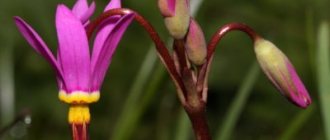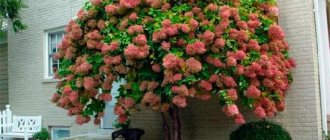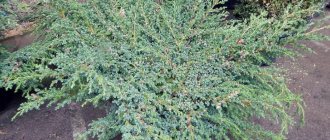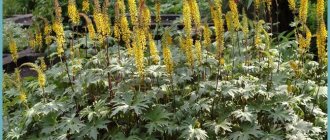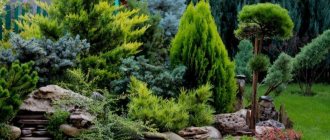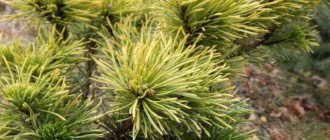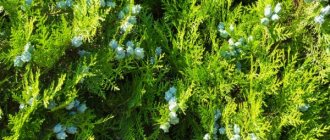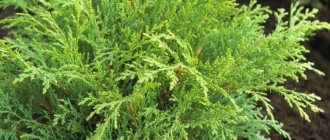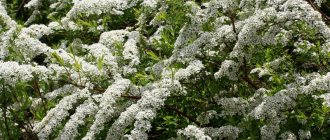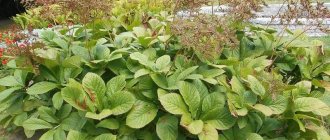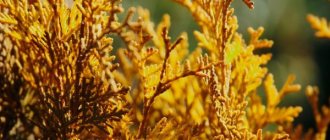Description of the common juniper Repanda
Common juniper Repanda (juniperus communis Repanda) is a perennial evergreen shrub belonging to the Cypress family. Externally, the plant is a low-growing seedling up to 50 cm high.
The crown is formed by branches spreading evenly in different directions. Its diameter is about 2.5 m.
The shoots are covered with needle-like, but not prickly, needles
In summer it has a green tint, but closer to winter it turns brown.
In August, cones appear on the branches. In young juniper they are round and light green in color. In adult crops they have a dark blue color with a grayish coating.
The shrub begins to bloom in early summer and bears fruit in the fall. As the needles age, they cover the soil with a thick, bright green carpet.
Frost resistance, drought resistance
Common juniper Repanda is a frost-resistant plant that can withstand temperatures down to -30 °C. This feature makes it possible to grow coniferous shrubs not only in the south, but also in central latitudes. Young specimens must be covered for the winter for the first few years.
In the process of evolution, culture adapted to ascetic conditions. The plant can grow in poor soils and survive for a long time without moisture. It is possible to grow Repanda in the Far North, but only if it is properly insulated in winter.
Juniper variety Repanda is a sun-loving crop that tolerates high temperatures well. However, dry air has a bad effect on the condition of the seedling. In dry summers, the shrub is watered regularly; in the evening hours, additional sprinkling is carried out.
Young seedlings are covered for the winter with spunbond or other available materials
Growth rate and size of Repanda juniper
The plant reaches a height of 30 to 50 cm. The crown grows in a dwarf form with many horizontal branches. Its circumference is on average 2-2.5 m. Juniper reaches such parameters by the age of 20, annually growing by 10 cm in width and 2-3 cm in height.
The growth rate largely depends on where and in what conditions the shrub grows. The slightest shading and poor soil greatly affect its condition. Pests and various diseases can slow down the growth of a crop or completely destroy it. Regular prevention and proper treatment will help prevent the occurrence of diseases.
Planting seeds and cuttings
For sowing seeds, berries that have not yet completely darkened are used; late harvesting is undesirable due to long germination. The seeds are first stratified by placing them in a moistened substrate of peat, sand and moss, and covering them with another layer of soil mixture on top.
During cold times, including winter, containers with seeds should be kept outside (about 5 months). Thanks to this hardening, rapid germination occurs. At the end of spring, the prepared material is sown in open ground, carrying out the usual agricultural work - watering, weeding and loosening. Grown sprouts can be moved to a permanent place of residence.
It is best to propagate Repanda by cuttings. Young shoots up to 10 cm long with a piece of bark are cut off in spring. After clearing the needles, keep the branches in a solution of a growth stimulator. To make roots form faster, the cuttings are planted in a peat mixture and covered with film. Plants should be kept in a dark room.
The main troubles at this moment are associated with constant moistening of the substrate and ventilation.
The formation of roots in juniper takes 1-1.5 months, and then it can be planted on the site.
Juniper Repanda in landscape design + photo
Horizontal juniper Repanda is an excellent element in landscape design that can decorate any garden plot. The low-growing shrub does not block other plants, but at the same time looks organic with them.
Gardeners with a spacious plot create a juniper lawn. In addition, Scandinavian-style rock gardens require Repanda’s presence. Bright green needles look advantageous against the background of plants with red leaves or flowers. The decoration of a Japanese-style garden will be a combination of bladderwort and juniper.
Juniper fits seamlessly into the lawn with other conifers
Sometimes gardeners plant areas with complex terrain with Repanda shrubs, which prevents the soil from crumbling near the stairs. Tip! Thanks to its ability to adapt to conditions of increased pollution, Repanda can decorate city parks and squares.
Compact juniper will help decorate large lawns or garden paths
Landscape
Juniper Repanda will be an excellent choice for landscape design:
- decoration of rock gardens, rocky areas, paths;
- filling spacious places;
- landscaping slopes and uneven areas (in the latter case it helps prevent soil subsidence);
- masking uneven terrain areas;
- decoration and landscaping of balconies, flat roofs, terraces, entrances to premises;
- decoration of parks and squares.
Common juniper Repanda is a beautiful evergreen shrub. Caring for it is simple and consists of regular watering, mulching, and protection from pests. With the help of this shrub you can create magnificent compositions in the garden.
Reproduction methods
Juniper is rarely propagated by seeds. This method is very labor intensive and requires patience. Seeds appear only in the second year of flowering of the bush. For this reason, gardeners prefer other propagation methods.
These include:
- cuttings - shoots obtained in the spring from young shoots are used for this;
The survival rate of seedlings in light soil substrate is more than 80%
- layering - this method is considered the fastest.
A branch growing close to the ground is fixed in the hole and sprinkled with substrate
After a year, the cuttings are separated from the bush and transplanted to another place.
Each of the above methods has its own advantages and disadvantages. But the most effective method of propagating creeping shrubs is layering. It can be implemented almost throughout the entire territory of Russia.
Let's talk about the features of planting juniper
The fact is that any type of juniper (especially Cossack) needs special conditions during the planting process. First of all, you should always remember that this plant is planted exclusively in sunny areas, otherwise it will simply lose its decorative properties. The only exception to the rule is the common juniper.
In landscape design, it is important to take into account that between these plants there should be a distance of at least half a meter (this is if the juniper is a small species) and one and a half to two meters for large plant species. Otherwise, subsequently there will be no distance between them, and they will begin to obscure each other
Another important point is that you should not plant them next to low-growing plants, which will lack both light and nutrition. The best option is to plant juniper around the perimeter of the house, as well as in front of the house.
Thus, you will get some kind of original hedge. Sometimes the plant is located in a checkerboard pattern throughout the area or, for example, near a rock garden. After which the pots with young plants are placed in the order in which they are planned to be planted. Container plants must be well saturated with moisture, for which they are kept in a container of water for two hours. Next, a hole is prepared, which should be slightly larger than the pot itself. Before planting plants, it is recommended to dig up the area to the depth of a shovel, clear it of any debris and fertilize it. A drainage layer is made at the bottom of the pit, for example, from sand or broken brick. The layer should have a thickness of 15 to 20 cm. Then the roots of the plants are covered with a soil mixture of turf, sand and peat, with peat making up two parts of the entire mixture, and the remaining components - one at a time. If the plants are large, the root collar at the time of planting should be located slightly higher than the edges of the soil surface.
Planting and caring for common juniper Repanda
Juniper is planted either in spring (late May) or autumn (in October).
The Repanda variety shrub should be planted in well-lit areas. Even slight shading will negatively affect the decorative properties of the plant. The soil for planting can be either limestone or sandy. Before planting, it must be loosened and fertilized. The soil mixture is prepared from peat, sand and turf soil in a ratio of 2:1:1.
The dimensions of the planting pit depend on the dimensions of the root system. The hole should be 2-3 times larger than the earthen ball.
Important! If you need to plant several bushes, then leave at least 2 m between them.
A drainage layer consisting of expanded clay and broken bricks is poured into the bottom of the pit. The seedling is placed in the planting hole and covered with soil. After planting, the plant is watered abundantly with warm water, and then the soil is covered with sawdust.
Brief information about the species
- Color : silver green
- Height : by the age of 10 reaches 30 m.
- Crown width : 1.5 m.
- In which regions does it grow : the plant has good frost resistance and can withstand temperatures down to -29°C, so it is readily grown not only in the south, but also in the middle, central and northern latitudes, provided it is well insulated for the winter.
- Planting features : dig holes at a distance of 0.5 to 2 m, depending on the size of the bush. The depth of the hole should be 2-3 times greater than the root system or earthen coma. A sunny place with some shade is suitable.
- Immunity : high resistance to disease is observed if competent and timely care is provided.
- Life expectancy : from 100 to 500 years, the indicators are influenced by region and care.
Wall in the living room - 100 photos of beautiful walls for the living room
Aftercare
Young Repanda, after being transferred to the ground, requires increased attention. For high viability of juniper, it requires regular irrigation, loosening and placement of mulch.
Watering and fertilizing schedule
After planting, the Repanda variety shrub is watered 1-2 times a week. In summer, the plant is sprayed in the morning and evening 2-3 times a week. To water one bush, you need to take at least a bucket of water.
Since the culture is unpretentious in care, fertilizing is carried out only once a year in the spring. For this purpose, mineral fertilizers based on phosphorus, nitrogen and potassium are used. If the soil on the site is not very fertile, then fertilizing is applied monthly during the growing season.
In dry weather, juniper is watered 2-3 times a week.
Pruning rules
Repanda juniper does not require formative pruning. The branches of the bush always grow symmetrically, forming a rounded crown. If the plant is planted near the border, then it is allowed to trim the long shoots a little.
Sanitary pruning of juniper is carried out in spring or autumn. The gardener should remove damaged and dead branches.
Important! There is no need to thin out the plant too much. The Repanda variety is considered a slow-growing crop, so it will take several years to restore the crown.
Mulching, loosening the soil
Before watering the plant, the gardener should remove weeds and thoroughly loosen the soil. When the moisture is absorbed, the tree trunk circle is covered with a mixture of peat, sawdust and wood chips. Mulching helps retain moisture in the soil and protects the root system from freezing.
Preparing for winter
Preparing juniper for winter begins with abundant watering. It is held in October-November. After this, the shoots of the bush are tied with twine so that the snow does not damage them in winter. In early November, the tree trunk circle is generously mulched with peat (layer 10-12 cm), and then covered with spruce branches. The procedure for preparing the crop for winter will not take much time, but will help the plant adapt to the cold faster.
Landing
During boarding, you must familiarize yourself in detail with the rules of this procedure. The further growth of the bush will depend on this. After all, each plant requires an individual approach. Read more about this later in the article.
Landing dates
Experienced gardeners recommend planting in the spring so that the plant has time to get stronger before the onset of winter cold. If you purchased a seedling in a container, then such planting material can quickly adapt to a new place. It can also be planted in the autumn. The main thing is to create favorable conditions for the plant after the procedure: ensure daily watering and periodic mulching of the soil.
Pests and diseases
Repanda juniper can suffer from both diseases and pests. If you weed the beds in time and avoid waterlogging the soil, you will be able to prevent the occurrence of many diseases.
Diseases that Repanda may suffer from:
- rust appears due to the high salt content in the soil;
- yellowing of needles occurs due to excess or lack of moisture;
- Schutte - this disease changes the color of the needles to orange. Over time, growths appear on it;
- The fungus causes drying of the bark, as well as the growth of warts and ulcers.
Important! Completely damaged branches are cut off and burned.
In addition to various diseases, juniper can be attacked by insect pests. For example, active reproduction of scale insects leads to curvature of shoots. And over time, the spider mite completely entangles the plant.
To avoid pest damage, Repanda is treated with insecticides. As a preventive measure, in spring and autumn, carefully dig up the soil and remove all weeds.
Yellowing of needles can occur due to a lack or excess of fluid
Recommendations
Landing
Container plants are planted all year round, but the best planting times are spring and autumn. Dig a hole larger than the root ball of soil; if the soil is bad, then make the planting holes even wider. Place the seedlings in the center and cover them with a mixture of garden soil and compost (1:1). Then water, add about 6 cm of mulch (sawdust, peat, hay or fresh grass).
Care
At first, Repanda juniper needs even soil moisture, so weekly watering is necessary. Then a regime is set according to weather conditions. Winter care involves tying branches to relieve snow pressure. The spread of a few pests and diseases of coniferous shrubs is reduced by careful weeding of the tree trunk.
To diversify the color scheme of the landscape, in addition to the main background, we recommend taking horizontal juniper Andorra Compacta, which has similarities with Juniperus communis Repanda
, but differs in the bluish tint of the needles.
Description of the plant
Juniper (Cypress family) is a coniferous plant widely in demand in landscape design. Due to the presence of a variety of shapes and sizes (from narrow and pyramidal giants to creeping dwarfs), it is suitable for realizing any gardener’s idea. Columnar junipers are used as an accent in a landscape composition and are also suitable for laying hedges. Creeping varieties look great in rock gardens and rockeries next to various ground covers and hosts. With the help of cutting and shaping, which the bush tolerates well, it can be given almost any shape.
Juniper in landscape design
The air of the area where juniper grows is saturated with a unique aroma: the plant emits a large amount of phytoncides.
The noble colors of evergreen needles range from bright green to steel blue, with some varieties adding shades of yellow and gold.
The remarkable benefits of juniper are:
- undemanding to soil fertility
- shade tolerance
- drought resistance
- frost resistance (-40gr)
- longevity
- highly decorative regardless of the season
Juniper
Diseases and their treatment
Due to the poisonous properties of juniper, pests rarely bother this plant. Moreover, they are afraid not only of poison, but also of the unpleasant smell of the coniferous representative. During its youth, the bush can be attacked by mites, aphids and scale insects. However, to combat them, a plant insecticide or the drug “Fitoverm” is sufficient.
The gardener needs to take the issue of juniper diseases extremely seriously. Young bushes quite often suffer from spring sunburn. The main signs of the disease are yellowing of the crown and shedding of needles. To avoid such an unpleasant situation, it is recommended to cover the bushes with spruce branches at the end of February.
Fungal infections pose a serious danger to Cossack juniper. For this reason, it is strictly forbidden to plant coniferous bushes near rosaceous plantings, namely pears, apple trees, and rowan trees. These trees are susceptible to fungal diseases that reproduce by spores and are carried through the air by gusts of wind, and accordingly, can affect plantings growing nearby. The first sign of a fungal infection is the appearance of growths on the branches, a change in their shape and subsequent death. If suddenly at least one sign of disease appears on the juniper, it is necessary to urgently cut off the affected area and burn it. The bush itself should be sprayed with a fungicide solution.
Another serious disease that juniper can contract is Biatorella canker. The main signs are the appearance of growths on the bark, the bush itself turns yellow, and the needles fall off. The cause of this disease is mechanical damage through which fungi penetrate into the plant. A 1% solution of copper sulfate helps in the fight against the disease. In this case, diseased branches are cut off, and the cut areas are treated with garden varnish.
Another unpleasant disease that affects the root system of Cossack juniper is fusarium. The infection enters the plant through contaminated soil. First, the root system of the bush is damaged, then the feeding process is disrupted, the needles change color, the tops of the shoots begin to turn red, then the branches dry out and the bush dies. If this disease occurs, it is necessary to spray the soil under the plant and the entire bush with Fitosporin or Fundazol. Affected areas are cut off and burned.
Chinese juniper
Chinese juniper is a name that summarizes many varieties imported to Europe from the Far East. Scaly juniper, which can be found in the eastern part of the Himalayas, has paw-like branches with bluish needles. This is one of the most famous varieties of this species, but is not resistant to frost. But most of the other subspecies of Chinese juniper can be grown well in our latitudes, and they are often used as hedges.
Chinese juniper has spherical cones, although they can also be angular with four, maximum eight scales up to 9 mm in diameter. The shoots of the plant are quite slender, not exceeding 1.5 mm in thickness. This is where the similarities among all types of Chinese juniper end. Otherwise, the appearance of this plant can be very diverse - from tall pyramidal forms to low-growing creeping ones.
Those plants that grow in “columns” or “pins” have gray or bluish-green needles.
Those subspecies of Chinese juniper that are short in stature are not suitable for creating a hedge. There are also quite a lot of such types. In addition, Chinese juniper has a tendency to freeze. If the temperature in winter drops beyond -30, it should therefore be covered for the winter.
Another species that is worth mentioning is the Cossack juniper, which is very common in our latitudes. It is found in many areas and its dark green color is very attractive. True, in our conditions this plant does not exceed 1.5 meters in height, which allows it to be used only for spot plantings.
Propagating juniper by seeds is a thankless task. The seeds must be stratified twice in different modes, then scarified (cut the seed coat), and seedlings can be expected in a year at best, or even after two or even three years. Therefore, it is better to do cuttings and grafting onto a standard.
